Just a quick update.
<SNIP>
Today I will be testing the new isolator. After finishing my testing , I will share my test setup for confirmation.
<SNIP>
I'm looking forward to the updated Katana.
I need to post about my test setup and plans, likely this weekend. BUT I'll share that my next trials will be powering the output stage from a separate +-15V supply using Sparkos discrete regulators mounted right on top of the input headers for ultra-short paths. Very curious how this will compare to the built-in +-15V supplies.
I haven't tried a lot of combos yet, mostly focusing on how good I can get it with the best power setups I can throw at it. I HAVE found it responds well to power upgrades, even one I expected to be a minor change.
No comments on sound until later.
Greg in Mississippi
P.S. I want to say many kudos to Ioan and everyone at Allo for working this new DAC so hard and effectively. It's got to be a little scary for them to do so in such a visible and public manner. They have been VERY responsive to questions and requests and have worked to make this introduction a clean experience for all involved, from the initial testers to those ordering the units early in the process to those sitting on the fence. THANKS Ioan and the gang!
Last edited:
@cdsgames
I'm wondering if that output filter behavior will actually also depend on the input of the amp you're attaching.
Amp input stages also do some filtering. There might even be this or that interference between these filters.
I used to run my own ES9023 without any filter at the output. And that sounded most clean to me.
I'm wondering if people who take the whole subject serious should have a very close look at what their amp
is doing on the input.
Another filter subject - the internal DAC filters.
Is there a chance that the Sabre DAC filters can be bypassed?
On the Boss and Piano that was possible by feeding 352,8/384 material.
and to me that sounded best.
I'm not saying that e.g. the Apodizing filter sounds flawed. I like what I hear.
I'm just wondering if the filter can be bypassed.
I'm wondering if that output filter behavior will actually also depend on the input of the amp you're attaching.
Amp input stages also do some filtering. There might even be this or that interference between these filters.
I used to run my own ES9023 without any filter at the output. And that sounded most clean to me.
I'm wondering if people who take the whole subject serious should have a very close look at what their amp
is doing on the input.
Another filter subject - the internal DAC filters.
Is there a chance that the Sabre DAC filters can be bypassed?
On the Boss and Piano that was possible by feeding 352,8/384 material.
and to me that sounded best.
I'm not saying that e.g. the Apodizing filter sounds flawed. I like what I hear.
I'm just wondering if the filter can be bypassed.
Hi,
Rotary encoder integrated and making use of the very nice 32-bit hardware volume controller on ES9038
http://www.esstech.com/files/3014/4095/4308/digital-vs-analog-volume-control.pdf
The mount for the encoder was made out of a section of one of the side panels and a spare part moodeCase front cover that had a double D hole and locking slot for the encoder shaft.
The encoder is an ALPS 688-EC12E2430804 (Mouser) The knob is for a vintage Fender Telecaster.
-Tim
Rotary encoder integrated and making use of the very nice 32-bit hardware volume controller on ES9038
http://www.esstech.com/files/3014/4095/4308/digital-vs-analog-volume-control.pdf
The mount for the encoder was made out of a section of one of the side panels and a spare part moodeCase front cover that had a double D hole and locking slot for the encoder shaft.
The encoder is an ALPS 688-EC12E2430804 (Mouser) The knob is for a vintage Fender Telecaster.
-Tim
Attachments
-
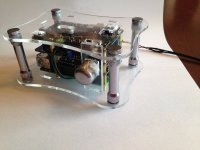 katana-rotenc-1.jpg102 KB · Views: 598
katana-rotenc-1.jpg102 KB · Views: 598 -
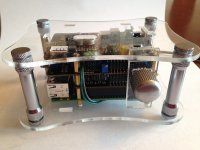 katana-rotenc-2.jpg105.7 KB · Views: 589
katana-rotenc-2.jpg105.7 KB · Views: 589 -
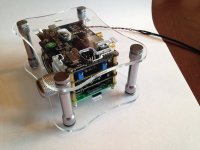 katana-rotenc-3.jpg109.6 KB · Views: 589
katana-rotenc-3.jpg109.6 KB · Views: 589 -
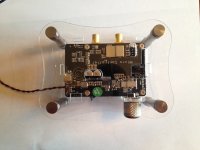 katana-rotenc-4.jpg91.6 KB · Views: 581
katana-rotenc-4.jpg91.6 KB · Views: 581 -
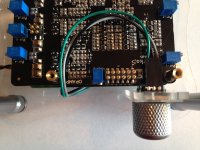 katana-rotenc-5.jpg141.4 KB · Views: 590
katana-rotenc-5.jpg141.4 KB · Views: 590 -
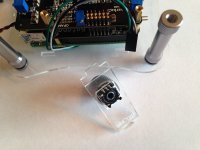 katana-rotenc-6.jpg109.3 KB · Views: 269
katana-rotenc-6.jpg109.3 KB · Views: 269 -
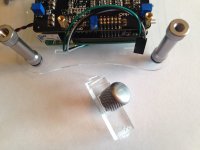 katana-rotenc-7.jpg106 KB · Views: 246
katana-rotenc-7.jpg106 KB · Views: 246 -
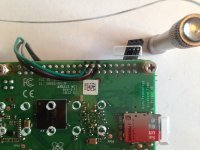 katana-rotenc-8.jpg106.2 KB · Views: 258
katana-rotenc-8.jpg106.2 KB · Views: 258
Very nicely done Tim!
Yep. Looks like a piece of art.
And I really like the nicely bent antennas on the output stage.
These really push the Feng Shui conformity of the whole thing.
And in a world where nobody wants knobs anymore, it's refreshing
to see that some people keep the tradition up.
Enjoy.
Last edited:
@cdsgames
I'm wondering if that output filter behavior will actually also depend on the input of the amp you're attaching.
Amp input stages also do some filtering. There might even be this or that interference between these filters.
I used to run my own ES9023 without any filter at the output. And that sounded most clean to me.
I'm wondering if people who take the whole subject serious should have a very close look at what their amp
is doing on the input.
Another filter subject - the internal DAC filters.
Is there a chance that the Sabre DAC filters can be bypassed?
On the Boss and Piano that was possible by feeding 352,8/384 material.
and to me that sounded best.
I'm not saying that e.g. the Apodizing filter sounds flawed. I like what I hear.
I'm just wondering if the filter can be bypassed.
Hi Soundcheck
the low pass filter (on summing opamps) should be almost independent of the next stage since a R exists in series between them. With my new mods , I find now that slow roll off filter is best.
I have not found a way to bypass the filters while checking the datasheet. I think is not possible.
Still more listening tests for the next day, but using only 2 PSUs on RPI and Microcontroller (and mods) there is a definitive improvement (in my personal opinion) in sound stage and removal of the slight hazing and fatiguing sound I was hearing on bookshelves .
After concluding the tests on my personal test rig I will send for validation to Greg (with his multiple low noise PSUs.) and we will see if we hear the same thing.
After concluding the tests on my personal test rig I will send for validation to Greg (with his multiple low noise PSUs.) and we will see if we hear the same thing.
Yep. Looks like a piece of art.
And I really like the nicely bent antennas on the output stage.
These really push the Feng Shui conformity of the whole thing.
And in a world where nobody wants knobs anymore, it's refreshing
to see that some people keep the tradition up.
Enjoy.
Oh dear, I'll twist the wires if it makes you feel better. Watch out for those delicate pins on the output board though, if they get bent they just break off :-0
Hi Soundcheck
the low pass filter (on summing opamps) should be almost independent of the next stage since a R exists in series between them. With my new mods , I find now that slow roll off filter is best.
I have not found a way to bypass the filters while checking the datasheet. I think is not possible.
I think ESS chips have a bypass_osf mode that allows use of an external upsampler but when enabled it looks like you lose things like the nice volume control.
Hi,
Rotary encoder integrated and making use of the very nice 32-bit hardware volume controller on ES9038
http://www.esstech.com/files/3014/4095/4308/digital-vs-analog-volume-control.pdf
-Tim
I was planning to do something similar. I like the option of having a manual control as well - for quick adjustments and to keep the wife happy rather than having to bring up the tablet everytime. I notice that you have soldered to the GPIO on the back of the RPi board itself? I guess this is because there is no access to the GPIO once the Katana boards are in place.
I was wondering about using this...
GPIO Interceptor GPIO Breakout for 40-pin Raspberry Pi – 4tronix
Looks like it plugs in to the GPIO of the RPi but has a side board to allow access to the GPIO pins otherwise obscured by the Katana. I prsume the Katana board can then simply plug into this (with taller spacers). Obviously the whole stack will now be even taller...
Yep. You seem to be right. bypass_osf is the ticket. It's already been discussed during ES9018 times.
And yes. VC seem to get bypassed. That's IMO not that serious.
With another sideeffect that VC on DOP wouldn't work anymore. That'd be a major drawback for DOP fans. Not even sure if DSD would work at all!??
SoftMute would also be gone.
The data would have to be supplied at 8xFS as it seems, which means e.g. 44k1 needs to be externally upsampled to 354k8.
48kHz would then be max FS considering the PI I2S limitation.
There'd be a bucket full of limitations. ( Not to forget - a great source of malfunctions)
The question will be - Is all this worth the hassle!?!?
Looking back at major projects like the "Soekris Filter Brewing" project and my experience with the Piano/Boss filters I'd say it's worth a consideration.
If I'd be Allo, I'd rather stay away from it though.
Since cdsgames is now aware of it he could play with it.
Obviously his fast developing "golden ears" will quickly come to a conclusion about it.
And of course above would show once more that Allo should consider a remote FW upgrade feature for next generation devices. Because
a firmware upgrade would be required again
All this discussion is IMO minor stuff about optional finetuning though.
Let's get back to the here and now.
The Katana - As Is - is a real nice and enjoyable DAC.
Enjoy.
And yes. VC seem to get bypassed. That's IMO not that serious.
With another sideeffect that VC on DOP wouldn't work anymore. That'd be a major drawback for DOP fans. Not even sure if DSD would work at all!??
SoftMute would also be gone.
The data would have to be supplied at 8xFS as it seems, which means e.g. 44k1 needs to be externally upsampled to 354k8.
48kHz would then be max FS considering the PI I2S limitation.
There'd be a bucket full of limitations. ( Not to forget - a great source of malfunctions)
The question will be - Is all this worth the hassle!?!?
Looking back at major projects like the "Soekris Filter Brewing" project and my experience with the Piano/Boss filters I'd say it's worth a consideration.
If I'd be Allo, I'd rather stay away from it though.
Since cdsgames is now aware of it he could play with it.
Obviously his fast developing "golden ears" will quickly come to a conclusion about it.
And of course above would show once more that Allo should consider a remote FW upgrade feature for next generation devices. Because
a firmware upgrade would be required again
All this discussion is IMO minor stuff about optional finetuning though.
Let's get back to the here and now.
The Katana - As Is - is a real nice and enjoyable DAC.
Enjoy.
Yep. You seem to be right. bypass_osf is the ticket. It's already been discussed during ES9018 times.
And yes. VC seem to get bypassed. That's IMO not that serious.
With another sideeffect that VC on DOP wouldn't work anymore. That'd be a major drawback for DOP fans. Not even sure if DSD would work at all!??
SoftMute would also be gone.
The data would have to be supplied at 8xFS as it seems, which means e.g. 44k1 needs to be externally upsampled to 354k8.
48kHz would then be max FS considering the PI I2S limitation.
There'd be a bucket full of limitations. ( Not to forget - a great source of malfunctions)
The question will be - Is all this worth the hassle!?!?
Looking back at major projects like the "Soekris Filter Brewing" project and my experience with the Piano/Boss filters I'd say it's worth a consideration.
If I'd be Allo, I'd rather stay away from it though.
Since cdsgames is now aware of it he could play with it.
Obviously his fast developing "golden ears" will quickly come to a conclusion about it.
And of course above would show once more that Allo should consider a remote FW upgrade feature for next generation devices. Because
a firmware upgrade would be required again
All this discussion is IMO minor stuff about optional finetuning though.
Let's get back to the here and now.
The Katana - As Is - is a real nice and enjoyable DAC.
Enjoy.
Ya, its gets really messy when you do osf bypass. In my mind it would only make sense to do it if there were a dedicated OSF board that did a better job then the on-chip osf and also provided volume, soft mute, etc.
Katana is super nice for sure
And of course above would show once more that Allo should consider a remote FW upgrade feature for next generation devices. Because
a firmware upgrade would be required again
Funny that you mention this today and I will explain why.
Since the beginning I have asked our team to have RPI based firmware upgrade..but the Microc MUC we used had a problem with the upgrade. For the past 3 months we exchanges emails an raised tickets with not much to show for. It was an Ack (if I remember correctly) that was not working properly for that MCU.
Well, today in the morning I received an email from our team saying that a fix was sent to us and in our preliminary testing..it worked.
So while testing was not done 100% , it seems that firmware field upgrade will be part of Katana
Still I will ask time to properly test .
Regarding power supplies, aside from the quality of each supply, there may also be the question of ground loops to consider. If there is a loop formed by ground wires to different grounded power supplies, then noise pick up should be according to loop area which should be kept small. At higher frequencies the loop may form a directional loop antenna. Depending on the ambient electronic noise environment where the dac and power supplies are located there could be large differences in the effects people may experience.
Then again, many wall wart and power bank type 5v power supply devices produce broadband switching noise up in the 1MHz to 4MHz band. Depending on the sensitivity of circuitry go power supply noise and or ground conducted EMI/RFI there can be adverse affects on sound quality in some electronic devices. In my particular experience with my own ES9038Q2M dacs, they can be sensitive to many different sources of power quality problems. Although it is possible to make very high quality, very low noise switching supplies, very few of them are designed to be that way. The best best is usually a linear supply using soft recovery rectifiers and multiple stages of linear regulation. However, making three or four of those seems prohibitive from a cost perspective.
I don't know how Allo powers Katana dacs in the lab test environment, but since it does not come with power supplies it seems up to Allo to at least qualify one comprehensive power solution that users wanting the best sound quality can duplicate. That should include measured performance numbers for each of the power supplies so people can have an idea of what is needed. Maybe the best choice could be one really good linear supply for the most critical circuits and maybe some filtering rather than separate supplies to keep noisy digital circuitry from adversely interacting with sensitive dac circuitry through power rails. I don't know what the best answer is and I am not privy to whatever testing Allo actually does. It does seem to me that either they need to say more about the power needs of dac or say they are going to work with the user community to figure it out. It's just that somehow or other there needs to be way for everybody who wants the best sound quality to know what they exactly need to do to get it.
Then again, many wall wart and power bank type 5v power supply devices produce broadband switching noise up in the 1MHz to 4MHz band. Depending on the sensitivity of circuitry go power supply noise and or ground conducted EMI/RFI there can be adverse affects on sound quality in some electronic devices. In my particular experience with my own ES9038Q2M dacs, they can be sensitive to many different sources of power quality problems. Although it is possible to make very high quality, very low noise switching supplies, very few of them are designed to be that way. The best best is usually a linear supply using soft recovery rectifiers and multiple stages of linear regulation. However, making three or four of those seems prohibitive from a cost perspective.
I don't know how Allo powers Katana dacs in the lab test environment, but since it does not come with power supplies it seems up to Allo to at least qualify one comprehensive power solution that users wanting the best sound quality can duplicate. That should include measured performance numbers for each of the power supplies so people can have an idea of what is needed. Maybe the best choice could be one really good linear supply for the most critical circuits and maybe some filtering rather than separate supplies to keep noisy digital circuitry from adversely interacting with sensitive dac circuitry through power rails. I don't know what the best answer is and I am not privy to whatever testing Allo actually does. It does seem to me that either they need to say more about the power needs of dac or say they are going to work with the user community to figure it out. It's just that somehow or other there needs to be way for everybody who wants the best sound quality to know what they exactly need to do to get it.
Last edited:
I've been needing to post here for a couple of weeks and finally made the time to do so.
I've had a Katana in my hands about as long as anyone on here. AND I'm still not ready to post much in the way of results. Allo, to their credit, has listened to the feedback of the initial users and have been making adjustments based on suggestions. I don’t want to say a lot about the sound until some of these kinks are worked out. BUT I thought I'd update on where I'm at and where I'm going with it.
To start off, I've been going slow with the Katana because:
1. I really understand the impact of break-in for the unit, as I use some of the same parts in my builds. The supercaps take about 2 weeks of run time to lose a sandy texture and over-emphasized bass. The PPS film caps take about a week to lose a bit of tizzy on the top end. AND the ceramic caps need about 2-3 weeks to lose more sandiness. My run-in time has been slowed by a summer with many days where thundershowers and storms are predicted, days when I don't leave my systems plugged in for fear of a nearby lightning strike. BUT it now has nearly 3 weeks of running time.
2. Work has been busy. Sorry, I have to pay the bills too!
3. I decided to upgrade the main AC source in my systems, going from PS Audio P10's to DSP15s (see 'bills' above). I wanted to have these in my systems to be able to review the Katana in the best setup I can muster. Those arrived today and are in my systems running in as I type.
My plans?
As I’ve given the Katana run-in time, I have run through different power options with the goal of getting the best performance I can from the unit. I can make better and more informed decisions on the overall sound of the Katana when it is at its best. Also knowing how it sounds at its best, I can betterassess lower-end power configurations while preserving as much of the top performance available from the unit.
This is what I EXPECT my top performing configuration will look like, though I haven't put it all together yet with the Katana:
- RPi modified with Alexey's (ldovr.com) power mezzanine board, fed from a dual Stammheim 3||LT3045 regulator board, with each side fed from an Uptone Audio LPS-1.2 (which provides 2A for the RPi).
- The new Allo isolator board (which I don't even have yet). Powered separately if that can easily be done.
- DAC board fed from another LPS-1.2.
- Microprocessor board fed from another dual Stammheim 3||LT3045 regulator board (or OPC's 4||LT3042 board) with 2 more LPS-1.2s feeding each side. This provides sufficient current to run the DC-DC converters to power the output stages. BUT I bet the reference setup will have them turned off and...
- Output stages powered from an external +-15V supply. My standard digital source output stage supply starts with a mid-sized R-Core transformer feeding a pair of Jensen 4-pole capacitors via some good soft-recovery diodes. I’m feeding this raw DC to a +-15V Sparkos regulator pair on a protoboard stacked on top of the Microprocessor board. Based on how this sounds, I may try some other regulators later.
Over the top? Yes.
More complex and expensive than almost anyone else will use. Yes.
BUT what will likely produce the best performance from the unit. ABSOLUTELY YES!
What many forget is for DACs in the $1000-$6000 USD range, the basic DAC, controller, and output stages are not much different between a DAC at the level of the Katana and many that cost much more. The power supplies are what make the big boys sound like they do. AND they along with the fancy cases are what make up much of that selling price.
I like to use the example of the Sony HAP Z1-ES, as it is a full digital source with a small processor board, a DSP board, and a dual-mono DAC setup, so not too dissimilar from one of our RPi setups with a Katana. I have one of these and modified it extensively a few years back. It is still in my top tier of digital sources, though now towards the middle-bottom. Stock It has 3 power transformers, with a total of 7 raw DC supplies and 8 rails and retailed new at $2000 USD. Oh, and it has a fancy case too!
In my experience, power supplies make or break the SQ of a setup. Get them right and a unit will shine. Don't and it never will.
Personally, knowing Allo's experience and track record, I expect the Katana to be produce a very high level of performance if care is taken in one’s personal implementation. AND I know it needs the best supplies to get that. Hence what I've been building towards.
Later, I WILL provide some down-scale suggestions that do a good job of preserving as much of that top-level performance as possible.
Results so far? Again, I'm not going to say much as the Katana is still a bit of a work in process. That in my opinion is a good thing. Allo is not only judging the Katana with their own critical ears and extensive test gear, but listening to what the 'Beta Testers' are saying too. BECAUSE it is still in flux, I'm not going to comment on the sound quality MUCH at this time.
What I WILL say is as I have been scaling the power supply mountain up to what I expect will be the best, this week I got to a configuration that produced a significant breakthrough in the sound quality, to my ears, and in my system. I'm not going to say more until Allo can duplicate and look at whether they need to make some adjustments in the design based on what I found. BUT what I'm hearing now puts the Katana in the same class as my best digital sources... the modified Sony HAP Z1-ES I mentioned above, Ian Canada's prototype ES9028Q2M RPi DAC using Onetics output transformers, 2 modified Soekris DAM 1021 DACs (1 fed from an SDTrans384, the other from an RPi / isolator / Kali stack), and finally a couple of Twisted Pear Buffalo-IIIPro setups, one their ES9028 chip version, the other their ES9038 version, both fed from RPi stacks AND with Ian's 1st Gen FIFO ahead of the DAC board (so I can easily convert them to pure-sync mode once the firmware is available from TP).
Note that all of these have pretty extensive power supply setups, roughly equivalent to what I am and will be using on the Katana. In most cases they use some of the exact same power supplies (plug-compatible). So apples to apples.
That's where I'm at. Likely more in the next few weeks as the breakthrough I mentioned above is assessed by Allo. And more from me as my new AC power sources run-in AND I try more power options. Oh, and get the new isolator to try.
I will provide some musings on lower-end power options in the next week or two also, mostly to get some discussion going and hopefully more suggestions on great options.
Greg in Mississippi
I've had a Katana in my hands about as long as anyone on here. AND I'm still not ready to post much in the way of results. Allo, to their credit, has listened to the feedback of the initial users and have been making adjustments based on suggestions. I don’t want to say a lot about the sound until some of these kinks are worked out. BUT I thought I'd update on where I'm at and where I'm going with it.
To start off, I've been going slow with the Katana because:
1. I really understand the impact of break-in for the unit, as I use some of the same parts in my builds. The supercaps take about 2 weeks of run time to lose a sandy texture and over-emphasized bass. The PPS film caps take about a week to lose a bit of tizzy on the top end. AND the ceramic caps need about 2-3 weeks to lose more sandiness. My run-in time has been slowed by a summer with many days where thundershowers and storms are predicted, days when I don't leave my systems plugged in for fear of a nearby lightning strike. BUT it now has nearly 3 weeks of running time.
2. Work has been busy. Sorry, I have to pay the bills too!
3. I decided to upgrade the main AC source in my systems, going from PS Audio P10's to DSP15s (see 'bills' above). I wanted to have these in my systems to be able to review the Katana in the best setup I can muster. Those arrived today and are in my systems running in as I type.
My plans?
As I’ve given the Katana run-in time, I have run through different power options with the goal of getting the best performance I can from the unit. I can make better and more informed decisions on the overall sound of the Katana when it is at its best. Also knowing how it sounds at its best, I can betterassess lower-end power configurations while preserving as much of the top performance available from the unit.
This is what I EXPECT my top performing configuration will look like, though I haven't put it all together yet with the Katana:
- RPi modified with Alexey's (ldovr.com) power mezzanine board, fed from a dual Stammheim 3||LT3045 regulator board, with each side fed from an Uptone Audio LPS-1.2 (which provides 2A for the RPi).
- The new Allo isolator board (which I don't even have yet). Powered separately if that can easily be done.
- DAC board fed from another LPS-1.2.
- Microprocessor board fed from another dual Stammheim 3||LT3045 regulator board (or OPC's 4||LT3042 board) with 2 more LPS-1.2s feeding each side. This provides sufficient current to run the DC-DC converters to power the output stages. BUT I bet the reference setup will have them turned off and...
- Output stages powered from an external +-15V supply. My standard digital source output stage supply starts with a mid-sized R-Core transformer feeding a pair of Jensen 4-pole capacitors via some good soft-recovery diodes. I’m feeding this raw DC to a +-15V Sparkos regulator pair on a protoboard stacked on top of the Microprocessor board. Based on how this sounds, I may try some other regulators later.
Over the top? Yes.
More complex and expensive than almost anyone else will use. Yes.
BUT what will likely produce the best performance from the unit. ABSOLUTELY YES!
What many forget is for DACs in the $1000-$6000 USD range, the basic DAC, controller, and output stages are not much different between a DAC at the level of the Katana and many that cost much more. The power supplies are what make the big boys sound like they do. AND they along with the fancy cases are what make up much of that selling price.
I like to use the example of the Sony HAP Z1-ES, as it is a full digital source with a small processor board, a DSP board, and a dual-mono DAC setup, so not too dissimilar from one of our RPi setups with a Katana. I have one of these and modified it extensively a few years back. It is still in my top tier of digital sources, though now towards the middle-bottom. Stock It has 3 power transformers, with a total of 7 raw DC supplies and 8 rails and retailed new at $2000 USD. Oh, and it has a fancy case too!
In my experience, power supplies make or break the SQ of a setup. Get them right and a unit will shine. Don't and it never will.
Personally, knowing Allo's experience and track record, I expect the Katana to be produce a very high level of performance if care is taken in one’s personal implementation. AND I know it needs the best supplies to get that. Hence what I've been building towards.
Later, I WILL provide some down-scale suggestions that do a good job of preserving as much of that top-level performance as possible.
Results so far? Again, I'm not going to say much as the Katana is still a bit of a work in process. That in my opinion is a good thing. Allo is not only judging the Katana with their own critical ears and extensive test gear, but listening to what the 'Beta Testers' are saying too. BECAUSE it is still in flux, I'm not going to comment on the sound quality MUCH at this time.
What I WILL say is as I have been scaling the power supply mountain up to what I expect will be the best, this week I got to a configuration that produced a significant breakthrough in the sound quality, to my ears, and in my system. I'm not going to say more until Allo can duplicate and look at whether they need to make some adjustments in the design based on what I found. BUT what I'm hearing now puts the Katana in the same class as my best digital sources... the modified Sony HAP Z1-ES I mentioned above, Ian Canada's prototype ES9028Q2M RPi DAC using Onetics output transformers, 2 modified Soekris DAM 1021 DACs (1 fed from an SDTrans384, the other from an RPi / isolator / Kali stack), and finally a couple of Twisted Pear Buffalo-IIIPro setups, one their ES9028 chip version, the other their ES9038 version, both fed from RPi stacks AND with Ian's 1st Gen FIFO ahead of the DAC board (so I can easily convert them to pure-sync mode once the firmware is available from TP).
Note that all of these have pretty extensive power supply setups, roughly equivalent to what I am and will be using on the Katana. In most cases they use some of the exact same power supplies (plug-compatible). So apples to apples.
That's where I'm at. Likely more in the next few weeks as the breakthrough I mentioned above is assessed by Allo. And more from me as my new AC power sources run-in AND I try more power options. Oh, and get the new isolator to try.
I will provide some musings on lower-end power options in the next week or two also, mostly to get some discussion going and hopefully more suggestions on great options.
Greg in Mississippi
- Home
- Vendor's Bazaar
- New FIFO buffer for RPI/SBCs